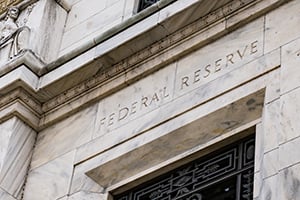One of the key sources of uncertainty that has driven the market pullback over the past weeks has been interest rates. Specifically, the rise in rates—and the fear that the Fed would tighten further—pulled growth stocks down, including many in the tech sector, and generated significant uncertainty around where the economy was going.

As Expected
Yesterday’s announcement from the Fed, followed by a press conference with Chair Jerome Powell, was supposed to resolve that uncertainty somewhat. And it did in many ways. The Fed kept rates unchanged, as expected, but hinted very strongly that a rate increase was coming in March, also as expected. The Fed took down its purchases of bonds in the open market, as expected, and announced it expected to stop them entirely in March, also as expected. So far, so good. Indeed, stocks jumped when the statement was released.
Then Things Got Interesting
It was at the press conference that things got interesting. Even as the market moved higher at the statement, it dropped sharply during the press conference, only to rally back to close to even by the end of the day. Today, the market has moved a bit higher, but it still remains close to recent lows.
So, what did the Fed say to drive that market action? For today, nothing special. As noted, everything that was announced was in line with expectations, and what the statement promised was more of the same. That did reduce uncertainty. In the press conference, however, Chair Powell started to get into some specifics. The economy was at full employment, for example, which was not in the statement. And inflation risks were to the upside, which wasn’t in the statement. Pretty much all of the press conference was along the same lines: that the Fed, while moving forward in a measured way, was much more concerned about inflation than employment and that it planned to do something about it. And the markets listened.
Market rate pricing now suggests the Fed might raise rates by 50 basis points in March, something it has not done since the mid-1990s. This would be a big deal. For the year as a whole, the betting now is on five hikes—or more—rather than the four expected before the meeting. One headline, in particular, noted that Powell “won’t rule out hike every meeting.” The perception of what the Fed is willing to do to get inflation under control has changed.
Something New to Worry About?
And this has replaced one set of uncertainties from before the meeting with another. Before, the question was whether the Fed would act or leave it too late. While markets had priced in substantial action, there were real questions about whether the Fed would act strongly enough to get inflation under control. The tone of the press conference, which was more hawkish than expected, raised the risk that the Fed would do too much and tighten policy enough to slow or even derail the recovery. It replaced one worry (continued inflation) with another (slower growth).
After the press conference, for example, the increase in the two-year Treasury yield was the highest since the start of the pandemic, and the spread between longer-term rates and shorter-term ones narrowed—a sign that markets are now expecting a slowdown. So the Fed, having made its point, is now facing the opposite set of worries. Powell just can’t win on this one.
Fed Leaving Its Options Open
Looking forward, though, the Fed has very likely accomplished its purpose here. The fear that it will not get inflation under control is now materially less. By pushing out a hawkish stance, Powell has calmed one set of current worries at the cost of stoking future worries. But he still has the option of the actual policy being easier, if those future worries really appear.
If we look at the press conference as an exercise in jawboning the market, it has been a success. The Fed has signaled that it will get inflation under control, no matter what, which solves a current problem. But it has conveniently left open just what it will actually do, which leaves its options for future problems open.
Originally published on CommonWealth.com
